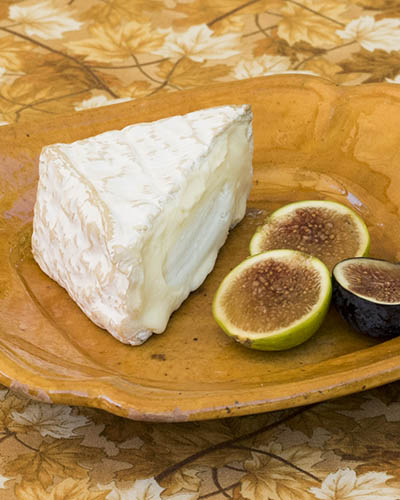Introduced in March of this year, Tomales Farmstead’s Teleeka is already outselling the four other cheeses made by this California creamery. I’m not surprised. Inspired by La Tur, the wildly popular bloomy-rind cheese from Northern Italy, Teleeka has a luscious factor that’s hard to resist.
As the “farmstead” in its name implies, the creamery specializes in cheeses made with milk from its own sheep and goats. But a near neighbor in rural Marin County has Jersey cows, and the creamery’s two cheesemakers began fantasizing about incorporating that extra-rich milk. For Teleeka, they blend cow, goat and sheep milks, as is done for La Tur, in the ratio of roughly 50/30/20. But because sheep’s milk yields a lot more curd than the other two, it contributes more than 20 percent to the cheese.
A long, slow coagulation with animal rennet allows acidity and flavor to build. It can take 12 to 14 hours for the curd to develop. Instead of salting individual cheeses—the common practice—cheesemakers Ashley Coffey and Hadley Kreitz salt the curd in the vat. After molding, the cheese is drained for two to three days, then unmolded and matured for seven to ten days before wrapping. Then out the door it goes—no longer a farmstead cheese but one that embraces West Marin’s history as cow country.
At two weeks old, the six-ounce square will have developed a thin, powdery-white surface bloom. (For the nerds: the rind is largely Geotrichum, with a little Penicillium candidum.) Over the next two to three weeks, the exterior will get a little gooier and the interior more creamy. Coffey says the creamery’s proprietor, David Jablons, likes Teleeka at four to five weeks from the make date. “I like it a little younger,” she told me.
Tamara Hicks
A four-digit make date is stamped on the wrap; you just have to know the code. The first two digits represent the week of the year; the second two digits represent the date of the month. So a make date of 3709 indicates that the cheese was made during this year’s 37th week (September 7-13) and, more precisely, on September 9.
Jablons and his wife, Tamara Hicks, have off-farm careers in San Francisco. He’s a renowned thoracic surgeon; she’s a clinical psychologist. I have no clue how they find the time to oversee this enterprise, but they are clearly passionate about their beautiful ranch, its history and its future. They have given all their cheeses Miwok names in reference to the area’s earlier inhabitants. Teleeka is the Miwok word for “three.”
This petite square, about an inch in height, has an edible rind with no hint of ammonia. The interior is paler than the butter color typical of cow’s milk cheese, with an oozy layer under the rind and a firmer core. Don’t make the mistake (as I did) of leaving the cheese at room temperature for too long or it may collapse. An hour is plenty.
Teleeka’s fragrance is subtle but lovely, hinting at fresh mushrooms and sour cream. A square purchased recently struck me as a bit too salty, but two prior samples did not. The three milks blend seamlessly; you can’t tease them apart. But taste Teleeka next to the creamery’s Kenne, a similar recipe using only goat’s milk, and you will detect the buttery contribution of the other milks.
Look for Tomales Farmstead Teleeka at Bi-Rite, Rainbow Grocery, Other Avenues, Cowgirl Creamery and Whole Foods (Valencia Street) in San Francisco; Berkeley Bowl, Pasta Shop and Star Grocery in Berkeley; Cal Mart in Calistoga; Woodlands Market in Kentfield; Summit Store in Los Gatos; Draegers in Menlo Park; Oxbow Cheese Merchant in Napa; Petaluma Market; Taylor’s Market in Sacramento; V. Sattui in St. Helena; Liberty Heights Fresh in Salt Lake City; Oliver’s Markets in Santa Rosa; DeLaurenti in Seattle; and Sonoma Market. I really enjoyed it with the Palacio de Fefiñanes Albariño from Spain.


